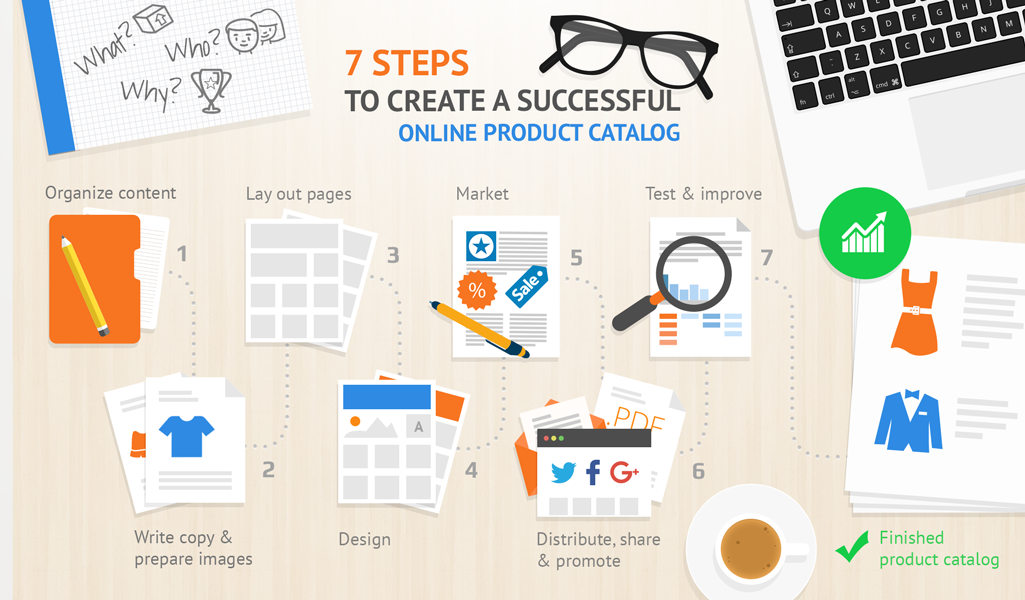Put Your Product Catalog on Autopilot
Easy Marketing Automation for Online & PDF Product Catalogs & Showrooms.

Automate Your Product Catalog Management

Save time with Workflow Automation
Use Zapier integration or our REST API to connect your services and apps (Google Sheets, Shopify, Gmail, etc.)
Use Zapier integration or our REST API to connect your services and apps (Google Sheets, Shopify, Gmail, etc.)

Streamline product and catalog updates
Always fresh product catalog information with automated product and image import and catalog generation.
Always fresh product catalog information with automated product and image import and catalog generation.

Automatically notify about catalog changes
Push and share your catalogs with your customers using different marketing channels.
Push and share your catalogs with your customers using different marketing channels.

Direct product orders & payments your way
Send, store and process product orders and quotes and customer information in your systems.
Send, store and process product orders and quotes and customer information in your systems.
Why Marketing Automation for Catalog Management?

Streamline your marketing functions
Marketing automation is the use of software to automate manual and repetitive marketing processes.
Software replaces humans with integrated set of services and apps connected together. Marketing automation makes business much more efficient and enables new fast processes.
When automation handle repetitive tasks, people are free to tackle higher-order problems and errors are reduced. An automated marketing can save time and resources, driving revenue while you focus on growing your business.
When automation handle repetitive tasks, people are free to tackle higher-order problems and errors are reduced. An automated marketing can save time and resources, driving revenue while you focus on growing your business.
Create an automated product catalog
As a manufacturer, wholesaler or retailer your customers may expect a product catalog in a variety of formats; online, as a PDF, and in print, in addition to your website and online or physical store.
If you need to sell your portfolio of products or services through multiple channels a product catalog could be vital to your business. Catalog Machine helps to create professional product catalogs easily and quickly especially if you are not a designer.
Catalog automation is making the process effective: the fast and easy way catalogs can be updated and shared in multiple channels speed up your growth and sales while producing fresh and error-free product catalogs.
If you need to sell your portfolio of products or services through multiple channels a product catalog could be vital to your business. Catalog Machine helps to create professional product catalogs easily and quickly especially if you are not a designer.
Catalog automation is making the process effective: the fast and easy way catalogs can be updated and shared in multiple channels speed up your growth and sales while producing fresh and error-free product catalogs.

Automate your product and catalog workflows
You can use our REST API
or Zapier for automation.
Zapier is an automation tool that lets you create workflows between your various apps and services. Zapier lets you link Catalog Machine to over 500 different apps like Google Sheets, GMail, Dropbox and Shopify.
Zapier is an automation tool that lets you create workflows between your various apps and services. Zapier lets you link Catalog Machine to over 500 different apps like Google Sheets, GMail, Dropbox and Shopify.
- Import, schedule and synchronize product data and images from different data sources, systems and apps
- Instantly rebuild product catalogs and Showroom on product updates and share fresh catalogs with your customers.
- Receive product orders, payments and quotes from Catalog Machine to store in your systems and notify your team.
Popular Zapier Integrations
Why Catalog Machine?
Import products and images from Etsy, Shopify, eBay, Magento or CSV
with one click and manage your own product database.
Create professional catalogs, wholesale line sheets, spec sheets for your products in
PDF & mobile-friendly HTML.
No special skills required.
Available Online 24/7.
Privacy levels and password protection.
Available Online 24/7.
Privacy levels and password protection.
Build customized catalogs with advanced templates for individual markets,
customers and events.
Share
your product catalogs online, social media,
send in email or download.
Optimized for Google and Facebook.
Embed your product Online or PDF catalog into your website pages customizing visual options.
Advanced text editing, image management
and design elements for you own custom content and product information.
Include pre-built Product Order Form or receive
customer orders & payments directly from any catalog.
Integration with e-commerce stores and automation tools
Build Online Product Catalogs for your Shopify, Etsy,
eBay, Magento,
PrestaShop, WooCommerce
stores and boost your marketing power.
Creating and automating catalog is easy and fast with Catalog Machine:
1
Add / import your product information and images
Use the Catalog Machine app to create, edit or import your products and images then quickly add them to your catalog template.
Extend with custom fields / variants / options including images, prices, barcodes, market description, specifications and more.
2
Create your design
Use catalog templates and layouts to easily display your product prices, images and description, or create your own catalog design with the flexible product catalog maker.
3
Custom content creation
Complete your catalog by adding custom text, images and marketing material
or build your own pages for company, order information or terms of business, product guides, articles and more.
4
Maintenance and security with ease
Re-import or change your products in the Catalog Machine database with automatic update in your catalogs.
Clone your catalog versions and set privacy levels up to password protection.
5
Share, promote and distribute
Share by email, social media as catalog URLs, download or send as a PDF, embed to your site quickly and cleanly
to make product marketing promotion painless.
6
Work with your team or multiple accounts
Build your catalog and update products with your team in multi-user mode.
Work as an agency with multiple accounts linked to your login.
Create and Automate Your Catalog Now »
Catalog Machine last month
3,598
Active Catalogs
269,270
Catalog Products
317,989
Catalog Views
26,405
product orders
Testimonials
7 steps for building a product catalog or product brochure that sells
Step 1. Organize content and products
- Understand both your products and the target audience.
- Realize where top sellers, discounts and deals need to be featured and how your products need to be grouped.
- Good product grouping, or product layout will maximize results.
- Consider including an order from, introduction, CEO’s message, editor’s notes, guides or contents page for ease of navigation.
Step 2. Write copy and prepare images
- Write with the core product benefit in mind for your reader, building the other information around the core benefit.
- Solving the problem or meeting the desire of the customer is often more important than how a product works, who made it, and how well it sells.
- Ensure a product’s value, and value to the buyer is detailed alongside the benefits and any relevant exclusivity.
- A beautiful image is “worth a thousand words” and it is true. Great product photography can make or break sales. Poor quality will vastly diminish the product’s value.
- Keep product descriptions well written but short. Maybe 50-150 words, focus on the main selling point but utilise features and benefits as much as how it works.
Step 3. Lay Out Pages
- Bestselling and high profit generating products should receive prime position and the most space allocation.
- Balance images and text throughout for the right mix of information and engagement.
- Only group products which are similar or related. Grouped items which are not related don’t work well.
- Maximise opportunities to cross sell, placing companion products together on a page can increase sales 5-15%.
- Upselling is an effective way of increasing order value and sales.
Step 4. Design
- Keep your catalog focused on the products, an overly detailed design could detract the reader from their purpose.
- Make sure design, image and copy are product oriented, clear and concise.
- Establish a design or template that you will use throughout, changing only for the eye catching bestselling, feature or surprise pages, then reverting to the familiar flow.
- Keep colours, typography, font and layout styles consistent and ensure your brand is prominent and well used throughout.
Step 5. Market
- Try testimonials, guarantees and assurances, company history or CEO’s message.
- Include visible mark down of product prices, featured products, bestsellers, deals and discounts.
- Market your products with the goal of selling them, good, concise descriptions, answering any objections and showcasing your goods.
- Link to more detailed descriptions on your website, channelling customers to where they can quickly buy there.
Step 6. Distribute, Share and Promote
- Use any digital channel you can access: email, website, social networks.
- Target your specific audience through savvy social media marketing application for maximum return.
- Make sure you cross sell by promoting your website alongside your catalog and your catalog on your website.
- Try email marketing of a digital product catalog is a practical way to engage passive or previous customers with your entire product lineup.
Step 7. Test and Improve
- Digital catalog creation software can be accompanied by precise analytics, often powered by or compatible with Google Analytics.
- Data mining the results can help to understand traffic sources and patterns, visitors and their behavior.
- A/B split testing of catalog versions (small variations of the same base catalog presented to similar visitors) helps to select winning combination of elements and products for the best performing catalog.
- Analysis, experiments, then recommendations, can help to improve an online catalog quickly and with much return. Unlike print catalogs, a digital or online catalog can be constantly improved with little additional cost.
Read more about these steps in our blog post
7 steps to create an online product catalog that sells
.








